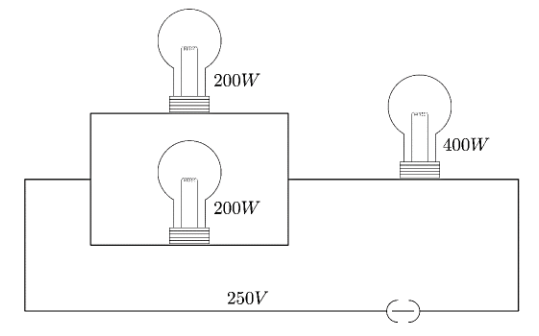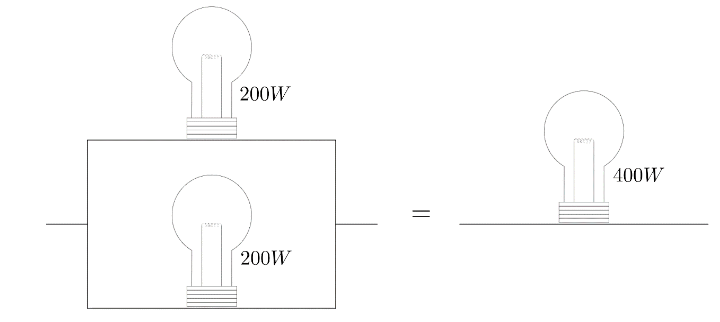
Three electric bulbs of \[200\,W\],$200\,W$ and $400\,W$ are shown in figure. The resultant power of the combination

A. $800\,W$
B. $400\,W$
C. $200\,W$
D. $600\,W$

Answer
507.6k+ views
Hint: Power is the rate of change of work done per unit time. When a bulb is connected with the battery it dissipates the electrical energy into light energy and heat So when we calculate the power it means how much energy dissipated by the bulb per second.
Complete step by step answer:
In this combination three electric bulbs have power ${{P}_{1}},{{P}_{2}}\And {{P}_{3}}$ where ${{P}_{1}}=200W$, ${{P}_{2}}=200W$, ${{P}_{3}}=400W$. In this arrangement ${{P}_{1}}$ and ${{P}_{2}}$ are connected in parallel but ${{P}_{3}}$ is connected in series with resultant of ${{P}_{1}}$ and ${{P}_{2}}$. We have to use the formula of power
$P=\dfrac{{{V}^{2}}}{R}$
Then, $R=\dfrac{{{V}^{2}}}{P}$
${{R}_{1}}=\dfrac{{{V}^{2}}}{{{P}_{1}}}$
$\Rightarrow {{R}_{2}}=\dfrac{{{V}^{2}}}{{{P}_{2}}}$
When the resistor connected in series then we have a formula of equivalent resistance
${{R}_{eq}}={{R}_{1}}+{{R}_{2}}$
Where, ${{R}_{1}}\And {{R}_{2}}$ is the resistance connected in series.
$\dfrac{{{V}^{2}}}{{{P}_{eq}}}=\dfrac{{{V}^{2}}}{{{P}_{1}}}+\dfrac{{{V}^{2}}}{{{P}_{2}}}$
Dividing both side by ${{V}^{2}}$, we get ${{P}_{eq}}$ of series combination
$\dfrac{1}{{{P}_{eq}}}=\dfrac{1}{{{P}_{1}}}+\dfrac{1}{{{P}_{2}}}$
When the resistor connected in parallel then then we have a formula of equivalent resistance
\[\dfrac{1}{{{R}_{eq}}}=\dfrac{1}{{{R}_{1}}}+\dfrac{1}{{{R}_{2}}}\]
Where, ${{R}_{1}}\And {{R}_{2}}$ is the resistance connected in parallel.
After putting the value of ${{R}_{1}}\And {{R}_{2}}$in above equation, we get
$\dfrac{{{P}_{eq}}}{{{V}^{2}}}=\dfrac{{{P}_{1}}}{{{V}^{2}}}+\dfrac{{{P}_{2}}}{{{V}^{2}}}$
After multiplying both side by ${{V}^{2}}$, we get ${{P}_{eq}}$ of parallel combination
\[{{P}_{eq}}={{P}_{1}}+{{P}_{2}}\]
In this problem power ${{P}_{1}}\And {{P}_{2}}$ are connected in parallel then resultant power of ${{P}_{1}}\And {{P}_{2}}$ is

${{P}_{eq}}={{P}_{1}}+{{P}_{2}}$
$\Rightarrow {{P}_{eq}}=200+200$
$\Rightarrow {{P}_{eq}}=400\,W$
But ${{P}_{3}}$ connected in series through ${{P}_{1}}\And {{P}_{2}}$ then resultant power of ${{P}_{1}},{{P}_{2}}\And {{P}_{3}}$

$\Rightarrow {{P}_{eq}}=\dfrac{1}{400}+\dfrac{1}{{{P}_{3}}}$
$\Rightarrow {{P}_{eq}}=\dfrac{1}{400}+\dfrac{1}{400}$
$\therefore {{P}_{eq}}=200\,W$
Hence, the resultant power of the combination is 200 W.
Hence, the correct answer is option C.
Note: Electric bulb converts the electrical energy into light energy and heat energy. In the series combination of resistor current is constant but in the case of parallel combination voltage is constant. Equivalent power means when we remove all three bulbs and connect a single bulb having the same resistance then power of a single bulb is equal to the equivalent power of three bulbs.
Complete step by step answer:
In this combination three electric bulbs have power ${{P}_{1}},{{P}_{2}}\And {{P}_{3}}$ where ${{P}_{1}}=200W$, ${{P}_{2}}=200W$, ${{P}_{3}}=400W$. In this arrangement ${{P}_{1}}$ and ${{P}_{2}}$ are connected in parallel but ${{P}_{3}}$ is connected in series with resultant of ${{P}_{1}}$ and ${{P}_{2}}$. We have to use the formula of power
$P=\dfrac{{{V}^{2}}}{R}$
Then, $R=\dfrac{{{V}^{2}}}{P}$
${{R}_{1}}=\dfrac{{{V}^{2}}}{{{P}_{1}}}$
$\Rightarrow {{R}_{2}}=\dfrac{{{V}^{2}}}{{{P}_{2}}}$
When the resistor connected in series then we have a formula of equivalent resistance
${{R}_{eq}}={{R}_{1}}+{{R}_{2}}$
Where, ${{R}_{1}}\And {{R}_{2}}$ is the resistance connected in series.
$\dfrac{{{V}^{2}}}{{{P}_{eq}}}=\dfrac{{{V}^{2}}}{{{P}_{1}}}+\dfrac{{{V}^{2}}}{{{P}_{2}}}$
Dividing both side by ${{V}^{2}}$, we get ${{P}_{eq}}$ of series combination
$\dfrac{1}{{{P}_{eq}}}=\dfrac{1}{{{P}_{1}}}+\dfrac{1}{{{P}_{2}}}$
When the resistor connected in parallel then then we have a formula of equivalent resistance
\[\dfrac{1}{{{R}_{eq}}}=\dfrac{1}{{{R}_{1}}}+\dfrac{1}{{{R}_{2}}}\]
Where, ${{R}_{1}}\And {{R}_{2}}$ is the resistance connected in parallel.
After putting the value of ${{R}_{1}}\And {{R}_{2}}$in above equation, we get
$\dfrac{{{P}_{eq}}}{{{V}^{2}}}=\dfrac{{{P}_{1}}}{{{V}^{2}}}+\dfrac{{{P}_{2}}}{{{V}^{2}}}$
After multiplying both side by ${{V}^{2}}$, we get ${{P}_{eq}}$ of parallel combination
\[{{P}_{eq}}={{P}_{1}}+{{P}_{2}}\]
In this problem power ${{P}_{1}}\And {{P}_{2}}$ are connected in parallel then resultant power of ${{P}_{1}}\And {{P}_{2}}$ is

${{P}_{eq}}={{P}_{1}}+{{P}_{2}}$
$\Rightarrow {{P}_{eq}}=200+200$
$\Rightarrow {{P}_{eq}}=400\,W$
But ${{P}_{3}}$ connected in series through ${{P}_{1}}\And {{P}_{2}}$ then resultant power of ${{P}_{1}},{{P}_{2}}\And {{P}_{3}}$

$\Rightarrow {{P}_{eq}}=\dfrac{1}{400}+\dfrac{1}{{{P}_{3}}}$
$\Rightarrow {{P}_{eq}}=\dfrac{1}{400}+\dfrac{1}{400}$
$\therefore {{P}_{eq}}=200\,W$
Hence, the resultant power of the combination is 200 W.
Hence, the correct answer is option C.
Note: Electric bulb converts the electrical energy into light energy and heat energy. In the series combination of resistor current is constant but in the case of parallel combination voltage is constant. Equivalent power means when we remove all three bulbs and connect a single bulb having the same resistance then power of a single bulb is equal to the equivalent power of three bulbs.
Recently Updated Pages
Master Class 11 Accountancy: Engaging Questions & Answers for Success

Master Class 11 Science: Engaging Questions & Answers for Success

Master Class 11 Business Studies: Engaging Questions & Answers for Success

Master Class 11 English: Engaging Questions & Answers for Success

Master Class 11 Computer Science: Engaging Questions & Answers for Success

Master Class 9 General Knowledge: Engaging Questions & Answers for Success

Trending doubts
Why is there a time difference of about 5 hours between class 10 social science CBSE

What is the median of the first 10 natural numbers class 10 maths CBSE

The Equation xxx + 2 is Satisfied when x is Equal to Class 10 Maths

Write a letter to the principal requesting him to grant class 10 english CBSE

A Paragraph on Pollution in about 100-150 Words

What are luminous and Non luminous objects class 10 physics CBSE




